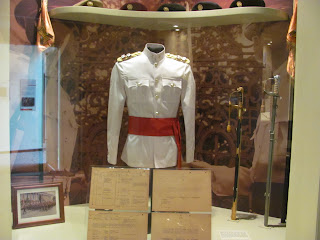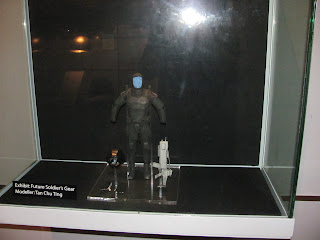I come from the UK, where we are lucky enough to have the Tank Museum: arguably the largest collection of Armour in the world, the Imperial War Museum, the Royal Armouries and dozes of military and armour collections. Of course, this is largely due to a long history of fighting people!
Singapore does not have the same number of museums and collections due in part to its short history as an independent nation and its geography/topography limiting the amount of armour in particular that was used on the island in the past. If it hasn't been here, no one has been able to collect it
The Army Museum of Singapore (ARMS) is a slightly different experience to what many might expect having experienced European military museums. The focus of the ARMS is information and experience rather than exhibits and artifacts. This is particularly salient when you remember that Singapore is a country that operates a system of National Service, which then gives many Singaporean men a shared experience from their two years service and 15 year reservist experience (although you can volunteer for the Police or Civil Defence Force [Fire and Emergency Forces] instead of military service)
NOTE: please excuse the quality of the pictures. Much of the museum is somewhat poorly lit and pictures without the use of a flash are very difficult to get
The Exhibitions and Areas of the Museum:
On entering the museum you start in what appears to be a temporary exhibition space which is used for displays on different subjects at different times. The theme of the current exhibition is 'SAF Overseas Operations' which runs until 31st May 2012.
This exhibition, presented almost entirely on large exhibition style board stands, deals with the deployments overseas of the Singapore Armed Forces from 1970 to the present
The exhibition begins with a large map of the world, with a light for the location of each deployment
The deployments show the wide range of roles carried out by the SAF during its deployments including Peacekeeping, huminitarian aid and a deployment as part of International Forces in the Gulf during recent conflicts.
Thereafter the boards provide information on specific deployments, and personal experiences from servicemen sent on those deployments
The next area is concerned with the history of the Singapore Armed Forces from its formation from two infantry regiments left when the British departed Singapore to the present again.
You enter through a large mock up of an inverted bus and the information given tells how civil unrest followed the British departure and the Government felt they needed a larger armed force both to aid in quelling unrest but also to defend Singapore against possible local threats at a time of possible weakness. To this end they set about building up their armed forces and brought in National Service, conscription of all Singaporean male citizens at age 18 for 18 months to two years service
After the bus the chronology of the SAF is told through a mixture of text and artifacts from given periods, such as pay and training books, code machines and so on.
There is also a very few weapons and uniforms, kit and regalia:
You then enter a hall where there are individual recollections and artifacts from those people:
(these are just two examples, there are more on display)
The around the corner to a display of gifts given by Armed Forces of other nations
You then descend some stairs (or the lift if you need it) and come back on yourself to enter galleries under the ones you just visited
The first has a mocked up sandbag wall and observation post. Here a member of staff controls an electronic shooting range. You fire a converted M16 at targets on a large video wall. Sadly the converted rifle is just as loud as the real one and my son doesn't like loud noises so I didn't get the chance to try it out!
Next to that is a gallery concerning recent peace-keeping activities, specific incidents and 'Special Operations',
Next is a mockup of part of an airliner fuselage, and a display concerning the hijacking of a Singapore Airlines flight 117.
In 1991 four individuals claiming to be Pakistani who landed the plane at Changi Airport and threatened to kill hostages if their demands were not met. The crisis was ended when Singaporean commandos stormed the plane, killed all the hijackers and released all the hostages unharmed
Leaving this room you enter a long gallery filled with cases of medals and decorations
Following this the final room is really speculation regarding the future of the SAF. There is some information regarding how their role may develop to meet new challenges such as terrorism in urban environments, but largely it is more speculative and more about developments in arms and military systems technology.
If I'm honest I have to say this was the least interesting area of the museum for me. I couldn't really see how it related to too much fact and seemed more of a way of just extending the chronological format beyond the present in a somewhat less serious way
Following this room you exit the museum building. Turn right immediately as you exit the door and head towards the access road
The Outside Exhibits
Outside the museum, on the other side of the access road is a small number of vehicle exhibits.
Note; you do need need to enter the museum to see these. If these are all you wish to see then you won't need a ticket for the museum to do so. They are not fenced in or enclosed in any way and are freely accessible
They are:
Landrover Ambulance on a section of bridge:
An Fast Craft Equipment Personnel with 4WD raider:
a V100
A Trunk Comms Truck
an M68 Gun Howitzer
An M113 in Singaporean configuration of course
And two AMX10Ps. these are not labelled at all, but I am reliably informed that at one point the SAF Considered the formation of a force for amphibious operations. A single company was equipped with these: the marine versions and was maintained for 10 years before the idea of a specialist unit, and the AMX10Ps were retired
There is also one other truck but it was being repainted to I was unable to approach it
Notably, all of the vehicles are kept in first class condition, which must present considerible difficulties in such a very hot and very wet climate!
How to get there:
Get the East West MRT line to the end of the line in the West: Joo Koon Station
Alight from the train and take the left hand exit (outside Union Containers), proceed to the corner of Joo Koon Circle and Benoi Road.
Turn left into Benoi Road and go all the way to the end; you should see signs on the way for the Singapore Discovery Centre
At the end of Benoi Road use the pedestrian crossing to cross Upper Jurong Road.
Before you cross you should be able to see the entrance to the Discovery Centre car park:
Once you are over the road turn left and head to the car park
In the Car/Coach Park you will see a covered walkway, follow it:
At the end you will get to the service road, turn left and continue under the walkway. From here the walkway has signs on it directing you to the museum
NOTE: the entrance to the museum is on the 1st Floor (UK convention)/ 2nd storey (European/ Singaporean convention)web:
http://www.mindef.gov.sg/imindef/mindef_websites/atozlistings/army/microsites/armymuseum/index.html
Tel:
6668 0338
Email:
armymuseum@sdc.com.sg
Note: the Museum is closed on Mondays, except for public holidays where the Monday is a public holiday in which case it is open



































Seems like a long-ish trek from the MRT. Any good shopping malls in the vicinity? If we visit S'pore again, I may park my wife there while I visit the museum! LOL!
ReplyDeleteThanks for the post!